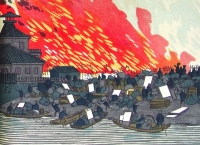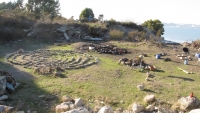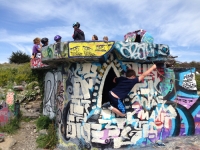Reading Cities, Sensing Cities: Reflections on Interpretation + Intervention
As part of the Global Urban Humanities Initiative Colloquium called Reading Cities, Sensing Cities we have asked students and visitors to write responses to each of the weekly guest lectures.
December 4, 2014
This week’s session was used to debrief and wrap up. In the blog below, one student reflects and gives her perspective on the Colloquium as a whole, highlighting some of the themes that came out of course discussion.
by Kirsten Larson
Maps, murals, walking sticks, sensors, stories, recordings, transcripts, scores, photos, poems, and film. I don’t believe I have left anything out, or, perhaps, I have left everything out. How we individually and collectively experience place is a difficult phenomenon to pin down – it is ephemeral yet grounded in the material of sidewalks and building edges and damp underpasses, it is socio-cultural, fleeting yet permanent, conscious and unconscious. We smell the city, and taste its bitter coffee, feel its cracked lanes under thin bike tires, see its foggy hills in the distance, and hear the rumble of helicopters over midnight protests.
As a collection of lectures, conversations, and reflections, Reading Cities, Sensing Cities was a thread of re-tellings, a series of modes through which we investigate and represent the myriad of multi-sensory experiences that compose the city body. Broad in methods, locations, and motifs the conversations were underpinned by two reoccurring themes:
- Questions of academic discipline or branch of knowledge – the lens we gaze through as architects, planners, writers, art historians, musicologists, and/or activists.
- Questions of representation, description, or portrayal. A dialectic process of reduction and addition, where we sense and select, sense again and draw atop, listen and write, erase and re-write.
Drawing from course discussions I will circle back to these two broad themes and pose new questions.
Throughout the semester there was a recurring discussion about ways in which different disciplines can learn from each other, particularly from varying forms of investigative methods. What are disciplinary ways of knowing? How do different disciplines interpret data (what we “sense” or “read” in the city)? Architecture (perhaps design in general) is a wholly nonlinear process of intuitive making and reflection, of layering, diagraming, distilling, often of moving along several paths simultaneously. The research question(s) and research method(s) are less clear than in City Planning or Art History. Perhaps it is methodologically more akin to creative writing, perhaps not. Reading Cities, Sensing Cities allowed us to put on a different set of glasses, seeing stories and urban phenomenon through different disciplinary lenses – a history of a Berkeley as told through a logo and mural project, the ephemeral everyday experience of mega-cities as told through a film where locational specificity is blurred, place and procession as notated and played along a musical score. How can borrowing from different disciplinary methods be emancipatory? In the lecture “Reading the City as a Blind Person,” Chris Downey (Architect) and Georgina Kleege (Writer) discussed non-visual characteristics of the city. In a blog post about this lecture, Jon Pitt describes this way of knowing as “narrative navigation.” He writes that this multi-sensory experience of cities presented by Downey and Kleege is exactly what writers try to evoke in stories.
Questions of representation were also recurring throughout the semester, sometimes leading to contentious discussions. What are some of the links between representation and power? How is representation related to (political) agency? What is an ethics of representation? How does an ethics of representation manifest within different disciplines? In a post about Darin Jensen’s lecture “Mission Possible: A Neighborhood Atlas,” Scott Elder describes the maps of San Francisco’s Mission District as “suggestive juxtapositions” where stories are being uncovered and told through visual data paring. Here the cartographer is an incredibly powerful agent, developing visual and political depictions of the city that tell untold stories, or bring new phenomenon to the surface. This example and many others from the semester demonstrate the false line so often drawn between “interpretation” and “intervention.” As cartographers, planners, writers, and film makers, we sense the city and through interpretation we represent a part of its story, and as we do this, in the forms of maps, films, songs, and plans we intervene and add to a collective body of knowledge and a collective material understanding of place. In urban story telling (in its broadest sense) what is the relationship between interpretation and intervention?

Kirsten Larson is a graduate student in the MArch/MCP dual-degree program at the UC Berkeley College of Environmental Design.
Tokyo’s Flow: The Importance of Material in Historical Tokyo
 As part of the Global Urban Humanities Initiative Colloquium called Reading Cities, Sensing Cities we have asked students and visitors to write responses to each of the weekly guest lectures. November 20, 2014 The Tokyo Model: Lessons in Slum Non-Clearance from the World’s First “Megacity” Jordan Sand (Japanese History and Culture, Georgetown University) Presentation available here. Video of the conversation available here. Professor Sand presented his research on the activities of a Tokyo slumlord at the turn of the 20th century. by Yael Hadar No phenomenon can be explained outside of its context. In his lecture, “Lessons in Slum Non-…
As part of the Global Urban Humanities Initiative Colloquium called Reading Cities, Sensing Cities we have asked students and visitors to write responses to each of the weekly guest lectures. November 20, 2014 The Tokyo Model: Lessons in Slum Non-Clearance from the World’s First “Megacity” Jordan Sand (Japanese History and Culture, Georgetown University) Presentation available here. Video of the conversation available here. Professor Sand presented his research on the activities of a Tokyo slumlord at the turn of the 20th century. by Yael Hadar No phenomenon can be explained outside of its context. In his lecture, “Lessons in Slum Non-…
“Invoking” The Spirits of History: Tokyo’s Nishimaru-cho
 As part of the Global Urban Humanities Initiative Colloquium called Reading Cities, Sensing Cities we have asked students and visitors to write responses to each of the weekly guest lectures. November 20, 2014 The Tokyo Model: Lessons in Slum Non-Clearance from the World’s First “Megacity” Jordan Sand (Japanese History and Culture, Georgetown University) Presentation available here. Video of the conversation available here. Professor Sand presented his research on the activities of a Tokyo slumlord at the turn of the 20th century. by Jon Pitt In The Practice of Everyday Life, Michel de Certeau writes, “There is no place that is…
As part of the Global Urban Humanities Initiative Colloquium called Reading Cities, Sensing Cities we have asked students and visitors to write responses to each of the weekly guest lectures. November 20, 2014 The Tokyo Model: Lessons in Slum Non-Clearance from the World’s First “Megacity” Jordan Sand (Japanese History and Culture, Georgetown University) Presentation available here. Video of the conversation available here. Professor Sand presented his research on the activities of a Tokyo slumlord at the turn of the 20th century. by Jon Pitt In The Practice of Everyday Life, Michel de Certeau writes, “There is no place that is…
The Subtle Details of Community and City
As part of the Global Urban Humanities Initiative Colloquium called Reading Cities, Sensing Cities we have asked students and visitors to write responses to each of the weekly guest lectures. November 13, 2014 From 1904 Dublin to the Megacity: Public Access in Ulysses and Katarina Schröter’s The Visitor Catherine Flynn (English) Presentation available here. Video of the conversation available here. Flynn’s talk raised the question of urban knowing and related it to the literary and filmic representations of the city and megacity. by Yasir Hameed Professor Flynn’s talk last week discussed works by James Joyce (Ulysses) and Katarina Schröter (The…
Opportunities to Create an Inclusive Sense of Place
 As part of the Global Urban Humanities Initiative Colloquium called Reading Cities, Sensing Cities we have asked students and visitors to write responses to each of the weekly guest lectures. November 6, 2014 The Art of Change: Exploring Neighborhoods in Transition Sue Mark (marksearch) and Anisha Gade (City and Regional Planning and Architecture) Presentation available here. Video of the conversation available here. Mark and Gade discussed their project, Communities’ Crossing, a creative placemaking effort along San Pablo Avenue. by Yasir Hameed During Sue Mark and Anisha Gade’s presentation, it was stated that it is not possible for planners to create…
As part of the Global Urban Humanities Initiative Colloquium called Reading Cities, Sensing Cities we have asked students and visitors to write responses to each of the weekly guest lectures. November 6, 2014 The Art of Change: Exploring Neighborhoods in Transition Sue Mark (marksearch) and Anisha Gade (City and Regional Planning and Architecture) Presentation available here. Video of the conversation available here. Mark and Gade discussed their project, Communities’ Crossing, a creative placemaking effort along San Pablo Avenue. by Yasir Hameed During Sue Mark and Anisha Gade’s presentation, it was stated that it is not possible for planners to create…
Exploring Neighborhood Boundaries and Transforming Community
 As part of the Global Urban Humanities Initiative Colloquium called Reading Cities, Sensing Cities we have asked students and visitors to write responses to each of the weekly guest lectures. November 6, 2014 The Art of Change: Exploring Neighborhoods in Transition Sue Mark (marksearch) and Anisha Gade (City and Regional Planning and Architecture) Presentation available here. Video of the conversation available here. Mark and Gade discussed their project, Communities’ Crossing, a creative placemaking effort along San Pablo Avenue. by Yuqing Nie Last week, artist Sue Mark and urban planner/design researcher Anisha Gade gave a talk on their latest creative place-making…
As part of the Global Urban Humanities Initiative Colloquium called Reading Cities, Sensing Cities we have asked students and visitors to write responses to each of the weekly guest lectures. November 6, 2014 The Art of Change: Exploring Neighborhoods in Transition Sue Mark (marksearch) and Anisha Gade (City and Regional Planning and Architecture) Presentation available here. Video of the conversation available here. Mark and Gade discussed their project, Communities’ Crossing, a creative placemaking effort along San Pablo Avenue. by Yuqing Nie Last week, artist Sue Mark and urban planner/design researcher Anisha Gade gave a talk on their latest creative place-making…
Living Archives: Filling Silences in History
 As part of the Global Urban Humanities Initiative Colloquium called Reading Cities, Sensing Cities we have asked students and visitors to write responses to each of the weekly guest lectures. November 6, 2014 The Art of Change: Exploring Neighborhoods in Transition Sue Mark (marksearch) and Anisha Gade (City and Regional Planning and Architecture) Presentation available here. Video of the conversation available here. Mark and Gade discussed their project, Communities’ Crossing, a creative placemaking effort along San Pablo Avenue. by Jaime Gómez The tons of documents hidden in Archives with a capital “A” around the world and managed by public and…
As part of the Global Urban Humanities Initiative Colloquium called Reading Cities, Sensing Cities we have asked students and visitors to write responses to each of the weekly guest lectures. November 6, 2014 The Art of Change: Exploring Neighborhoods in Transition Sue Mark (marksearch) and Anisha Gade (City and Regional Planning and Architecture) Presentation available here. Video of the conversation available here. Mark and Gade discussed their project, Communities’ Crossing, a creative placemaking effort along San Pablo Avenue. by Jaime Gómez The tons of documents hidden in Archives with a capital “A” around the world and managed by public and…
The Albany Bulb and Ephemeral Layers of Territory
 As part of the Global Urban Humanities Initiative Colloquium called Reading Cities, Sensing Cities we have asked students and visitors to write responses to each of the weekly guest lectures. October 30, 2014 Nature, Culture, and Conflict at a Shoreline Landfill: The Albany Bulb Susan Moffat (Global Urban Humanities Initiative) Moffat presented on The Atlas of the Albany Bulb, her oral history and mapping project about a landfill on the eastern shore of San Francisco Bay, which has been the location of bitter battles between people holding different notions of the proper uses of public space, and of what a…
As part of the Global Urban Humanities Initiative Colloquium called Reading Cities, Sensing Cities we have asked students and visitors to write responses to each of the weekly guest lectures. October 30, 2014 Nature, Culture, and Conflict at a Shoreline Landfill: The Albany Bulb Susan Moffat (Global Urban Humanities Initiative) Moffat presented on The Atlas of the Albany Bulb, her oral history and mapping project about a landfill on the eastern shore of San Francisco Bay, which has been the location of bitter battles between people holding different notions of the proper uses of public space, and of what a…
Bay Area Landscapes and the Conflict Over Open Space
 As part of the Global Urban Humanities Initiative Colloquium called Reading Cities, Sensing Cities we have asked students and visitors to write responses to each of the weekly guest lectures. October 30, 2014 Nature, Culture, and Conflict at a Shoreline Landfill: The Albany Bulb Susan Moffat (Global Urban Humanities Initiative) Moffat presented on The Atlas of the Albany Bulb, her oral history and mapping project about a landfill on the eastern shore of San Francisco Bay, which has been the location of bitter battles between people holding different notions of the proper uses of public space, and of what a…
As part of the Global Urban Humanities Initiative Colloquium called Reading Cities, Sensing Cities we have asked students and visitors to write responses to each of the weekly guest lectures. October 30, 2014 Nature, Culture, and Conflict at a Shoreline Landfill: The Albany Bulb Susan Moffat (Global Urban Humanities Initiative) Moffat presented on The Atlas of the Albany Bulb, her oral history and mapping project about a landfill on the eastern shore of San Francisco Bay, which has been the location of bitter battles between people holding different notions of the proper uses of public space, and of what a…
Power and the Audiovisual
As part of the Global Urban Humanities Initiative Colloquium called Reading Cities, Sensing Cities we have asked students and visitors to write responses to each of the weekly guest lectures. October 23, 2014 Urban Space, Spectacle, Memory and Music in Nineteenth-Century Vienna Nicholas Mathew (Music) Presentation available here. Video of the conversation available here. Mathew presented on the role of music and sound in the emergence of modern civic sensibilities in Napoleonic Vienna, and how printed music came to shape a new politics of urban pedestrianism. by Brandon Harrell On October 23, Professor Nicolas Mathew gave…




